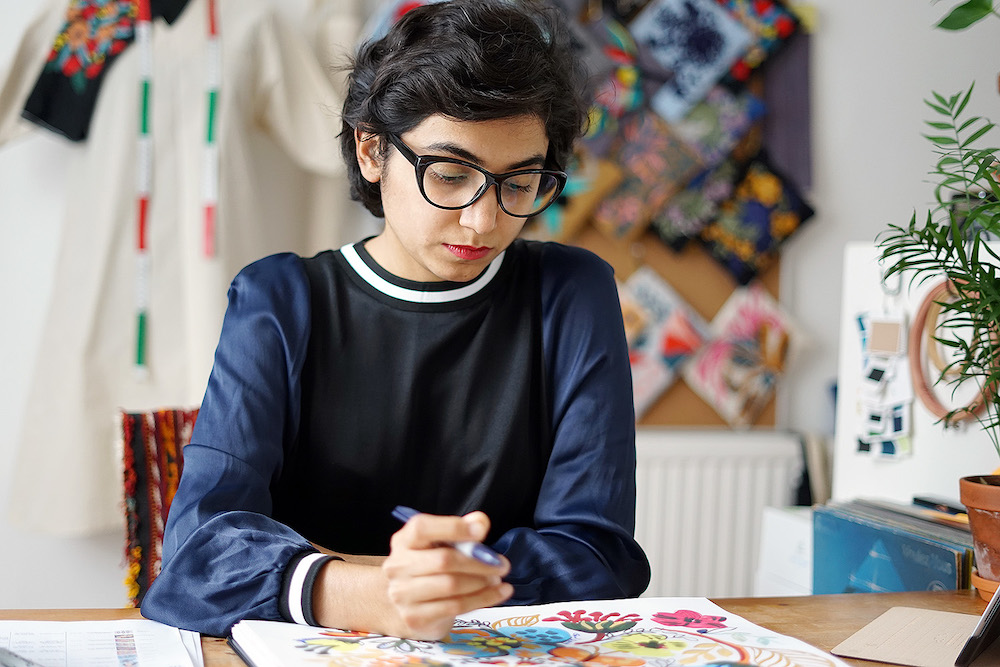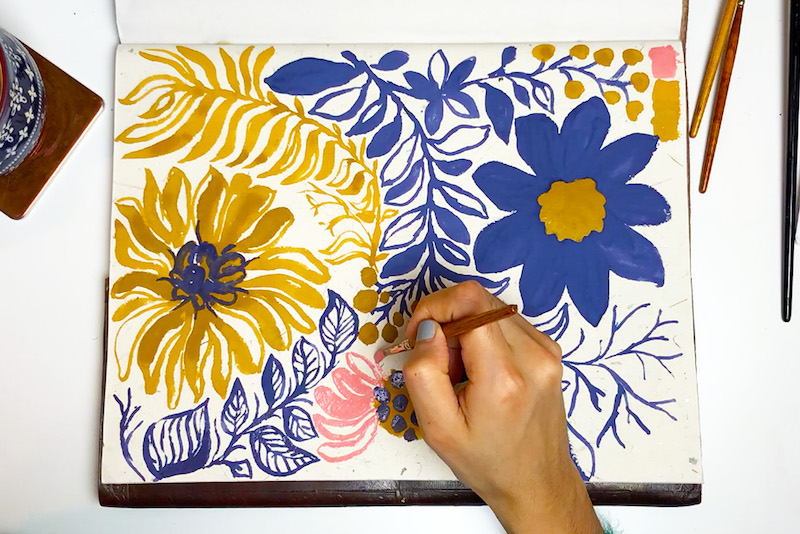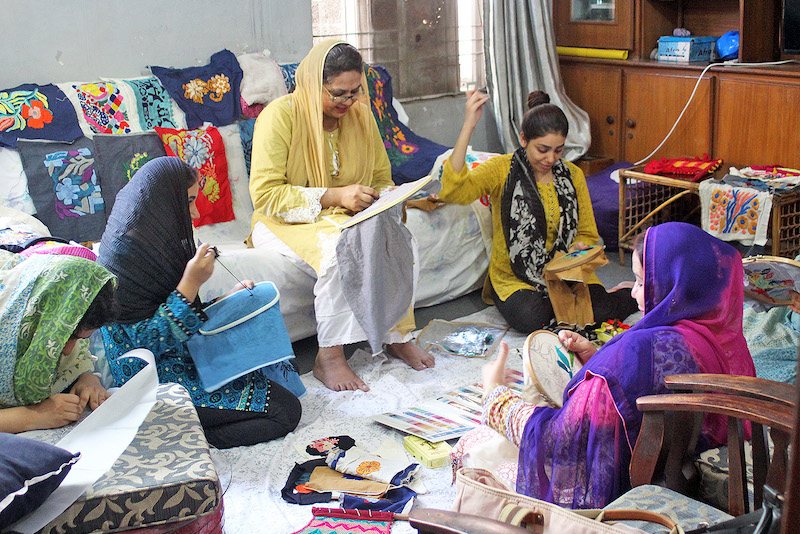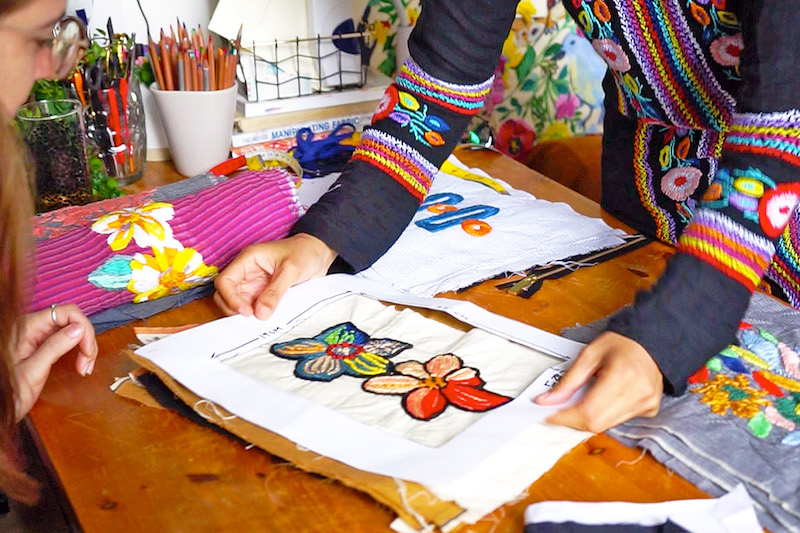Gul E Raana is the founder and creative force behind the hand embroidery London based brand – Wenlin Studio. Though only a couple of years old, the brand has a clear mission that resonates with their growing loyal clientele – to create ethical and responsible fashion products while empowering small communities of artisans.
As big fans of hand embroidery, we recently caught up with the brand’s founder and designer to find out more about the beautiful work she creates and her hopes for the brand’s future.
You launched Wenlin Studio in 2017. How did the idea to create your own brand came about?
Wenlin Studio originated as a reaction to mass production. After spending several years in the industry, I was fed up from designing and buying mass-produced fashion products and the amoral nature of it all.
I wanted to relate business with ethics and so I envisioned a brand that not only would support a good cause, to revive hand embroidery, but also to generate real value in society.

What were your challenges in starting your brand?
Establishing a community of artisans, who love their craft, was one of the most difficult tasks when we started. Establishing working parameters for the artisans, so I don’t have to travel back and forth to oversee every project, takes a lot of thought as well. Although it is more challenging to work with human beings than machines, I know this is the right direction and a very rewarding one as well.
Tell us a little more about your past fashion industry experience.
I have worked for different Western fast fashion brands for 8 years. I managed the design department in my last job. The premise of the fast fashion industry revolves around a cyclical waste generation activity. The industry bets on the consumer’s behaviour of discarding the product after every season (6 months) as it designs and produces something along the lines of the previous collections and hope the consumers will keep buying it. But there are signs that this cycle does not spin very predictably anymore. More than ever, people want to know where their products are coming from, who is making them, how are they generating any value, and are these products kind to the environment?
Read more: The Rise of Ethical Fashion Manufacturing
You spent some time working in China. What was living and working there like?
Life in China is all about convenience, efficiency and security. The society is highly focused on financial activities. Things work like clockwork. It has to be like that because the realities of survival and competition are huge challenges considering the large population.
After working for mass-market companies, what is it like to work with individual craftsmen and artisans now?
In a fast-paced industry, the goals are driven only by money and decisions that are taken with a corporate approach. Whereas working with artisans is fulfilling as you need to develop a relationship with a human being having a unique personality, that reflects in their work as well, something that can not be imagined in fast fashion.
A better way to start a designer label is by launching a ‘minimum viable product’.
You recently launched Wenlin Studio with just a single product – pouches. Why did you decide to launch with just pouches?
I think a better way to start a designer label is by launching a ‘minimum viable product’ and to consolidate its processes before expanding into something bigger. I wanted to launch my brand with hand-embroidered bags and pouches first to study the market response and then to expand it into a lifestyle brand as a response.
Are they all one-off designs and products or do you make a small production of each style?
We make a series for every design. But every product has one of a kind feeling because these are uniquely made by different artisans.

Looking at your pouches, your designs are very diverse. Where do you get inspirations from? Do you follow a theme? What is your design process?
The rhythms and movement in nature inspire me profoundly. I have a routine of drawing improvised compositions with gouache on paper. Out of these compositions, the ones I like the most are selected for a product. The process of making a bag involves creating tracings based on my compositions, with pouncing by a needle to help transfer the composition to the fabric for embroidery.
As a brand, you have made a public commitment to use 100% natural, surplus and recycled textiles. How and where do you source these from?
We source all of our materials in the local markets to reduce the carbon footprint of our product. We buy our fabrics and threads from the bazaars in Lahore. We source our recycled tape zips from YKK’s London showroom.
What are the challenges in working with surplus and recycled materials?
There can be unpredictable delays. But we are working with suppliers who are committed to providing consistent quality of natural and sustainable materials that make the delays worth a while.
How do you manage to control the work? The design and quality, from far away? Or do you travel regularly to supervise the work?
I have created and implemented process-based workflows with the help of cloud systems to work with my team and to follow up with artisans. I also have a production manager who manages artisans on a day to day basis.
The therapeutic idea of taking one stitch at a time makes this craft truly valuable and worthy of creating heirloom products.
Why did you choose to work with Pakistani artisans and not Chinese for example, given your experience and industry contacts there?
I was born in Lahore, Punjab, Pakistan so that naturally gave me exposure and advantage in developing relationships with artisans in that country as a start.

Why do you like hand embroidery so much?
Reviving hand embroidery has always been very personal to me. I grew up seeing women in my surroundings, embroidering traditional motifs on their dresses in between their daily chores. The therapeutic idea of taking one stitch at a time makes this craft truly valuable and worthy of creating heirloom products.
I studied the impact of the industrial revolution and its effect on traditional crafts in my Textile Design Degree and executed my visual ideas using hand embroidery in my final thesis. I refined my ideas over the span of my professional career and worked on a plan to play my part to make this craft financially viable again.
Is there a typical embroidery for the region you work with at the moment? Do you plan to work with other local artisans from other parts of the country/another country in order to add variety to your product range?
Punjab is famous for many techniques for embroidery, including Chikhan, Ari, Zardozi, Gota and Phulkari embroidery.
Phulkari literally means Flower Craft. This technique is featured in the majority of our products. We do have a plan to expand our project to other communities and contribute to reviving their local crafts as well.
You mention that your vision is to “empower communities” – what do you mean by that and how do you envisage to do that?
In every part of the world, people used to create beautiful objects by hand. The uniqueness of these items used to enrich their culture, rendering the world as a huge cultural mosaic.
The pursuit of beauty is what defines a community, its hopes and ideals.
As mass-production transformed the world into a global village of mass consumerism, these communities came to the brink of losing their identities. There is no time and resources commonly available now to produce handmade objects of beauty.

I think the best way to empower communities is to facilitate their pursuit of beauty.
We plan to empower the local artisans by making their craft financially viable by paving a way for their products to be sold internationally.
What are your plans for the future of the brand? Where would you like Wenlin Studio to be in 5 years time?
We plan to expand Wenlin Studio into a lifestyle brand in the coming years.
Our mission is to revive hand embroidery across multiple collections. We have already started working on a line of hand-embroidered dresses to be launched early next year.
Now that you are operational and “in business” – what are the biggest challenges you face now?
Production by far is the biggest challenge. Maintaining the same quality standard across the whole collection takes a lot of effort as everything is hand made by living humans and uniquely interpreted by every artisan.
Given your varied industry experience, if you can wave a magic wand – what changes would you make in the fashion industry?
Have less or no synthetic materials at all. It is such a pity that a lot of people are not aware that if they choose synthetic materials, they are actually buying plastic.
What does success mean to you?
Success results in fulfilment, which is a product of our moral choices that inspire. And if I inspire someone, even just one person along the way, that to me is a success.
What advise will you give new fashion entrepreneurs thinking of launching a brand in the future?
Whenever starting something new, we should always aim to solve a problem rather than creating one for the world.



